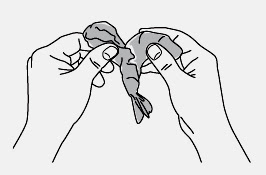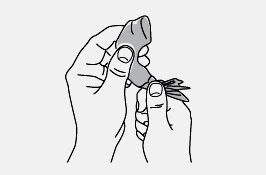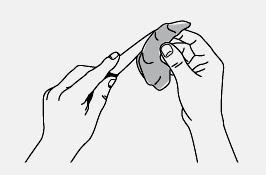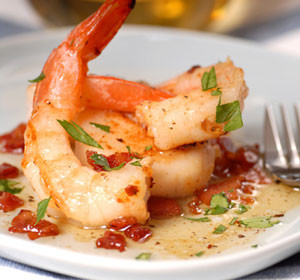Shrimp Tips
How to Buy
- Shrimp are sized by how many are in a pound with the price increasing as the shrimp become larger.
- The freshest shrimp of all are still alive. Their coloring is grayish olive or pinkish tan with translucent flesh.
- Fresh (non-live) shrimp indicate they are losing freshness when the head begins to turn black. If the head shows some black color, but the meat in the tail still appears translucent, then it is still fresh. Their shells should be translucent and moist, not dull or dry. Shells should not be slippery, have black edges or spots. There should be no drying on the meat.
- Shrimp should have a mild fresh smell of the sea. Never buy seafood with an off odor or a strong ammonia smell.
- Frozen shrimp with the head removed have meat that is white in color.
- Shrimp will occasionally have a shell discoloration called black spot or melanosis. This is not caused by bacteria and is not spoilage, but rather an enzymatic reaction caused by naturally occurring amino acids and sunlight. The shrimp are still be of good quality and safe to eat.
- Outside the coast states, shrimp are frequently sold peeled and deveined (P&D) in frozen five-pound blocks. Frozen shrimp should be packaged in a moisture and vapor proof wrap that fits closely around the product. There should be no ice crystals or other signs of thawing and refreezing.
- Check for the country-of-origin label and always purchase shrimp from the USA as America’s quality standards are the highest.
- Always check for date packaged.
- Grocery stores may also defrost P&D shrimp, display them on ice and sell them by the pound.
How to Store
Fresh: Refrigerate shrimp in cling wrap or airtight containers in the coldest part of the refrigerator. Keep your refrigerator at 32 to 38 degrees F. For best flavor and quality, use fresh shrimp within one to two days. Cooked shrimp can be refrigerated 3 to 4 days.
Frozen: Place frozen shrimp in home freezer immediately after purchase until ready to use. Keep freezer at 0 degrees F or below.
If purchasing raw shrimp for freezing, twist off the heads. Place headless, shell-on shrimp in freezer bags with ice water. Expel air and seal bags. Spread bas out in freezer for quick freezing. Shrimp maintain their quality for twelve months.
Thaw frozen shrimp in the refrigerator overnight.
How to Prepare
Shrimp can be cooked with the shell and head still on, which can both be removed after cooking, or the shell and head can be removed before cooking.
Shrimp can be cooked with the shell and head still on, which can both be removed after cooking, or the shell and head can be removed before cooking. If possible try to cook shrimp with the shell intact, as this will ensure a stronger and tastier flavor, with extra moisture added from the shell.
Deveining the shrimp is a matter of taste. Some people choose to remove the black “vein” that runs along the back of the shrimp. These veins are in fact edible but can sometimes taste gritty, particularly with larger shrimp. While it isn’t necessary to remove the vein, some people say the shrimp look and taste better when deveined.
- Shrimp cook well in or out of their shells, but they’re easier to devein before cooking.
- Run the deveiner or the tip of a small knife down the back of the shrimp. This will allow you to remove the vein.
- You may remove the shell at this time or boil with shell on and remove after cooking.
- If frying, shell should be removed first.
- You can devein shrimp while leaving the shell on (the shell adds flavor and can protect the meat if you’re grilling the shrimp.)
How-To: Peel and Devein a Shrimp
Even though they have plenty of tiny legs to trip you up, peeling a shrimp only takes a few seconds.
What You’ll Need
Running water, paper towels, a regular knife and a pair of hands.

Step One
First thing’s first—you’ll need to remove the head before cooking. Simply hold on to the body of the shrimp with one hand, and with the thumb and forefinger of your other hand, twist the head and pull it right off. Take a paper towel and wipe away any of the mess that’s left before rinsing off the shrimp.

Step Two
Now take your shrimp (cooked or raw), grab the tail with one hand and pull the legs and shell off with the thumb and forefinger of your other hand. The whole package should slide off in one piece.

Step Three
At this point, all you have left is the tail, which can be pulled off easily if you pinch it at the bottom and pull the shrimp from the top. Make sure you don’t leave the tail meat behind—it’s just as good as the rest.

Step Four
When you’ve gotten rid the shell, take a knife and make a small cut along the back of the shrimp. If you can see the vein, grab it and carefully pull it out; if you can’t see the vein, don’t worry with it.
SERVING SIZE
One pound of head-on white shrimp will yield .649 pounds after deheading.
One pound of head-on brown shrimp will yield .621 pounds after deheading.
How to Cook
Tip #1: A good rule of thumb is to check the color — shrimp should be a healthy pink.
Tip #2: Remove your shrimp from the refrigerator about 20 minutes before you plan to cook them. Rinse them under cool water. Shake the excess water from the shrimp.
Now let’s get cooking!
How to BOIL Shrimp

Photo Credit: Alabama Seafood
- Fill a large pot with enough water to cover the shrimp completely. Flavor the water with your favorite shrimp boil liquid or powder seasoning according to the package instructions.
- Bring the water to a full, rolling boil on high heat.
- Add the shrimp to the pot. Make sure they are completely submerged. Allow the shrimp to cook for 1 to 2 minutes. They will turn pink when they are finished cooking
- Drain the shrimp into a strainer or colander. They can be served immediately or at room temperature. Place in the refrigerator to chill if reserving for later use.
- You can either serve them with the peel on peel the shrimp before placing in the boiling liquid.
Classic Shrimp Boil Recipes
Zatarain’s Shrimp Boil Recipe
(Source: Zatarain’s)
Old Bay Shrimp Boil Recipe
(Source: Old Bay)
How to SAUTE Shrimp

Photo Credit: Alabama Seafood
- Heat a skillet over medium heat. Add a tablespoon of oil and swirl it around the pan.
- Season your shrimp on both sides with salt and pepper or your favorite seafood seasoning.
- Place the shrimp in the skillet. Arrange them in a single layer, making sure they don’t overlap.
- Cook the shrimp for 1-2 minutes, watching for the side touching the pan to begin to turn pink.
- Flip the shrimp and cook the other side. Cook for 1-2 minutes or until the second side is pink. The shrimp are finished when they have turned bright pink and the flesh is opaque white, rather than translucent
- Remove the shrimp from heat. Serve warm. Consider tossing the shrimp with pasta, fresh herbs and serve with a loaf of French bread.
How to GRILL Shrimp

Photo Credit: Alabama Seafood
- Light a coal or gas grill or kitchen grill pan to medium high heat.
- Thread the shrimp onto skewers. Pierce the skewers through both the tail and the thickest part of the shrimp toward the head. (Metal or wooden skewers are both fine to use. If you use wooden skewers, soak them in water for 10 minutes before threading the shrimp onto them. This will prevent the skewers from burning.)
- Consider threading the skewers with onion slices, green and red pepper slices, and other vegetables with the shrimp.
- Lightly cover the shrimp with olive oil on both sides. Season it with salt and pepper or your favorite seafood seasoning to taste.
- Lay the shrimp skewers on the grill. Cook them on one side for 2-3 minutes until you see light grill marks and the shrimp have started to turn pink.
- Turn them and cook on the other side for another 2-3 minutes. The shrimp are done when they’re bright pink and the flesh is opaque.
- Remove the shrimp from heat. You can serve the shrimp on the skewers or remove them.
- Consider serving them over a bed rice or mixed green salad.



